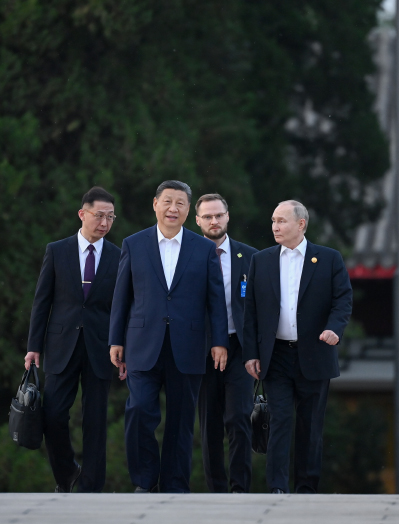| Voice |
| Economic and strategic synergy | |
|
|
 Chinese President Xi Jinping and Russian President Vladimir Putin at the Zhongnanhai leadership compound in Beijing on May 16 (XINHUA)
Russian President Vladimir Putin visited China on May 16-17, his 23rd trip to the country for state visits or international events. During the visit, he engaged in extensive discussion with Chinese President Xi Jinping, focusing on bilateral relations as well as international and regional issues of mutual interest. The documents signed and the itinerary arranged during this visit conveyed its special significance and led to fruitful results, enriching the cooperation between the two neighboring countries across all fields and levels. Setting the tone This year is the 75th anniversary of diplomatic relations between China and Russia. To commemorate this milestone, the two heads of state signed and issued a joint statement on deepening the China-Russia comprehensive strategic partnership of coordination for the new era. The statement covered a wide range of areas and underlined that relations between the two countries are at their highest level in history. During their talks, the leaders reviewed the successful experience in developing the China-Russia relationship, emphasizing the need to leverage complementary advantages to lift all-round strategic cooperation. President Xi said the most important conclusion drawn from the 75-year history of China-Russia relations is the necessity for two major neighboring countries like China and Russia to promote the Five Principles of Peaceful Coexistence, respect each other on an equal footing, build mutual trust, accommodate each other's concerns, and provide mutual assistance for development and revitalization of both sides. (The Five Principles of Peaceful Coexist-ence are mutual respect for sovereignty and territorial integrity, mutual non-aggression, non-interference in each other's internal affairs, equality and mutual benefit, and peaceful coexistence—Ed.) The approach underscored by Xi is not only the correct way for China and Russia to interact but also a model for major-country relations in the 21st century. Its underlying principles will serve as cornerstones to ensure the China-Russia strategic partnership remains stable and enduring. Since 2013, the two heads of state have met more than 40 times on different occasions, fully utilizing the strategic guiding role of head-of-state diplomacy and outlining a blueprint for the long-term and stable development of bilateral relations. During their most recent meetings, they stressed that China-Russia cooperation has withstood the test of international changes, demonstrating strong resilience. The current international and regional situations are undergoing profound changes. For example, the United States and some of its Western allies have politicized economic issues, engaging in camp confrontation and pursuing "small yard, high fence" type of trade and industrial protectionism, in attempt to isolate, and suppress even, their perceived strategic opponents. On the contrary, China and Russia oppose unilateralism, hegemonism and Cold War mentality. They are strengthening their cooperation and interaction within multilateral frameworks such as the Shanghai Cooperation Organization, BRICS (a group of emerging economies comprising Brazil, Russia, India, China, South Africa, Egypt, Ethiopia, Iran, Saudi Arabia and the United Arab Emirates—Ed.), the Group of 20 (a leading forum for global financial issues whose members include 19 major developed and developing countries, the European Union and the African Union—Ed.), and the Asia-Pacific Economic Cooperation (APEC). The two countries are promoting a new path of state-to-state relations that favors dialogue and partnership over confrontation and alliances. Together, China and Russia aim to safeguard the interests of developing countries on multilateral platforms such as the United Nations, advocate for equal and orderly world multipolarization and inclusive economic globalization.  Russian merchants visit the booth of Beidahuang Group, China's largest agricultural business, at the Eighth China-Russia Expo in Harbin, Heilongjiang Province, on May 18 (XINHUA)
Everybody wins During Xi and Putin's May talks, the two sides reached a broad consensus on deepening bilateral cooperation. Alongside the joint statement, the two countries signed a series of cooperation documents in areas such as trade, nature conservation, inspection and quarantine, and media. These agreements not only support the implementation of the pre-2030 development plan on priorities in bilateral economic cooperation, signed by Xi and Putin in March 2023, but can also enhance the synergy of the two partners' long-term strategies. Both countries today have to manage the major tasks of realizing modernization and national rejuvenation, and they need to continue to make concerted efforts across the board, all the while adhering to the development path that suits their individual national conditions. China and Russia support each other on issues concerning their respective core interests, which is the essence of their strategic partnership. They respect each other's cultural traditions and development models, and are continuously expanding exchanges in a wide range of areas, bringing more benefits to their respective populations. The two neighbors consider win-win cooperation to be the driving force of their relationship and work to foster a new paradigm of mutual benefit. In recent years, bilateral economic ties have gone from strength to strength, with China being Russia's largest trading partner for 14 consecutive years. Last year, two-way trade exceeded $240 billion, nearly 2.7 times that of a decade ago. In addition to expanding joint endeavors in traditional areas such as transportation, energy and agriculture, the two countries are also looking to unlock cooperation potential in the digital economy, e-commerce, technological innovation and green transformation. Exchanges in the fields of education, culture, science and technology, health and sports help boost people-to-people and cultural ties, and enhance mutual understanding and friendship. A new, major paradigm By upholding the principles of non-alliance, non-confrontation and not targeting any third party, the China-Russia relationship has become a prime example of a new form of international relations as well as of good-neighborly relations between two major countries. China and Russia always start from the fundamental interests of the two countries and their peoples, actively seek points of mutual interest, and deepen the integration of interests through cooperation. During their conversations, both Xi and Putin emphasized the need to abide by the purposes and principles of the UN Charter, respect the sovereignty and territorial integrity of all countries, respect and accommodate the legitimate security concerns of all parties, and build a balanced, effective and sustainable new security architecture. Strengthening communication on major international and regional issues, the heads of state underscored the need to enhance the synergy between the China-proposed Belt and Road Initiative, which aims to boost connectivity along and beyond the ancient Silk Road routes, and Russia's Eurasian Economic Union framework, an economic union and free trade zone consisting of countries located in Central and North Asia and Eastern Europe, to drive the common development of regional countries. China supports Russia's Greater Eurasian Partnership initiative, which aims to form a comprehensive, multi-level system of cooperation among regional countries. The two countries previously had already expressed, on different occasions, their highly aligned positions on major international issues. Both countries are committed to building a high-quality partnership that is more comprehensive, closer, more practical and more inclusive. They will unite with countries in the Global South, or the nations of the world that are considered to have a relatively low level of economic and industrial development and are typically located to the south of more industrialized nations, in the spirit of equality, openness, transparency and inclusiveness, and lead the building of a community with a shared future for humanity. BR The author is director of the Institute of Russian, Eastern European and Central Asian Studies at the Chinese Academy of Social Sciences Copyedited by Elsbeth van Paridon Comments to mamm@cicgamericas.com |
|
||||||||||||||||||||||||||||
|